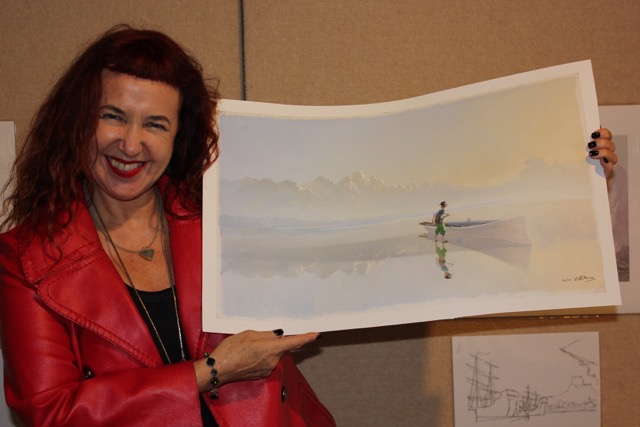Mask maker wins 2016 Patricia Wrightson Prize for Children’s Literature.
Comments Off on Mask maker wins 2016 Patricia Wrightson Prize for Children’s Literature.
Here I am at the Fremantle Literature Centre in WA, with a piece of the original artwork from Matt Ottley’s award winning Teacup.
Yesterday I matched Matt Ottley with his wonderful mask and just two days ago, he and writer Rebecca Young, won the Patricia Wrightson Prize for 2016. It is no surprise. His illustrations for Rebecca Young’s lovely text for the picture book Teacup are luminously beautiful. The print of the cover of the book I am holding is among the many original literary artworks on display at the wonderful Fremantle Literature Centre. The special thing about much work here is that you can see the artwork of entire books from rough sketches to final artwork. Many of the mask makers’ work has featured at the centre and over the next few weeks, I will post some pictures of them or their work at the Centre, either conducting young writers days or taking part in the wonderful Celebrate Reading Literature Festivals run by the centre.
This is the cover of Teacup:
This is what the judges of the Patricia Wrightson Prize said of the book, when they announced its win:
Teacup by Rebecca Young & Matt Ottley
Rebecca Young’s sparely written, multifaceted tale of a young refugee enables Matt Ottley’s glorious, painterly oil illustrations to shine in their moving picture book Teacup. The child character has to find a new home, leaving with only a book, a bottle, a blanket and a teacup filled with earth. The sea voyage tests the boy immeasurably with its variable, often confronting, weather and empty horizons. But the natural elements of stars and clouds, as well as occasional interaction with whales and an albatross, also provide succour. When a seed sprouts in the boy’s teacup, the story becomes transcendent with hope and life.
The masterful illustrations transpose the reader both onto and above the boy’s small boat isolated on the sea. Painted textures denote storm and stillness. Ottley’s signature high-angled long shots effectively position the boy as vulnerable. These perspectives are interspersed with closer eye-level views to develop the reader’s relationship with the character. Many illustrations fill the double-page to emulate the large canvas of the open seas, while others are panel-strips representing growth over time. The pictures, words and talisman of Teacup create a powerful yet tender allegory.

